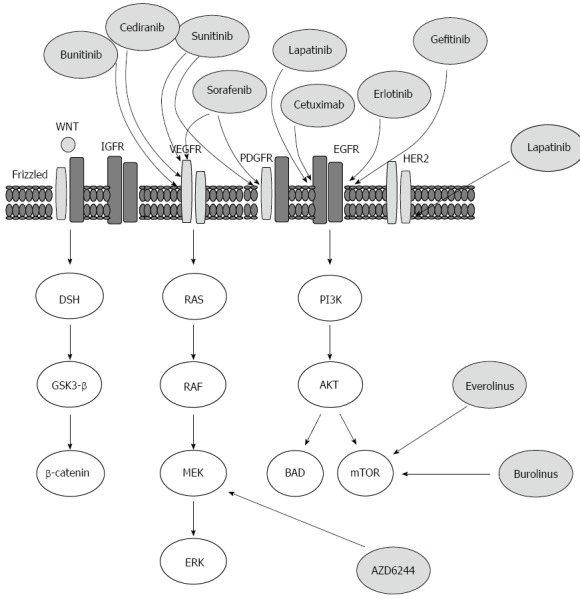Figure 3.

Outline of the targeted therapies, which are currently available or under development for the treatment of hepatocellular carcinoma, and the molecular targets on which they are believed to act upon. AKT: A protein kinase family of genes involved in regulation of cell survival, Bcl-2-associated agonist of cell death promoter (BAD), Bcl-2-associated death promoter; Disheveled (DSH) protein, downstream effector Disheveled; EGF: Epidermal growth factor; EGFR: EGF receptor; ERK: Extracellular signal-regulated kinase; Frizzled: A family of G-protein coupled receptor proteins that serve as receptors in the WNT/β-catenin signaling pathway; once activated: Frizzled leads to activation of Disheveled in the cytoplasm; GSK-3β: Glycogen synthase kinase 3β; HER2/neu: Human epidermal growth factor receptor 2, a cell membrane surface-bound receptor tyrosine kinase that is involved in the signal transduction pathways leading to cell growth and differentiation; MEK: Kinases that phosphorylate mitogen activated protein (MAP) kinase (MAPK); mTOR: Mammalian target of rapamycin; PDGFR: Platelet-derived growth factor receptor; PI3K: Phosphatidylinositol-3-kinase; PTEN: Phosphatase and tensin homolog, regulates cell-survival pathway; RAF: A MAP kinase kinase kinase (MAP3K) that functions in the MAPK/ERK signal transduction pathway; a serine/threonine-specific kinase; RAS: Prototypical member of the RAS superfamily of proteins; activation of RAS signaling causes cell growth, differentiation and survival; the dysregulation of RAS signaling can lead to oncogenesis and cancer.
